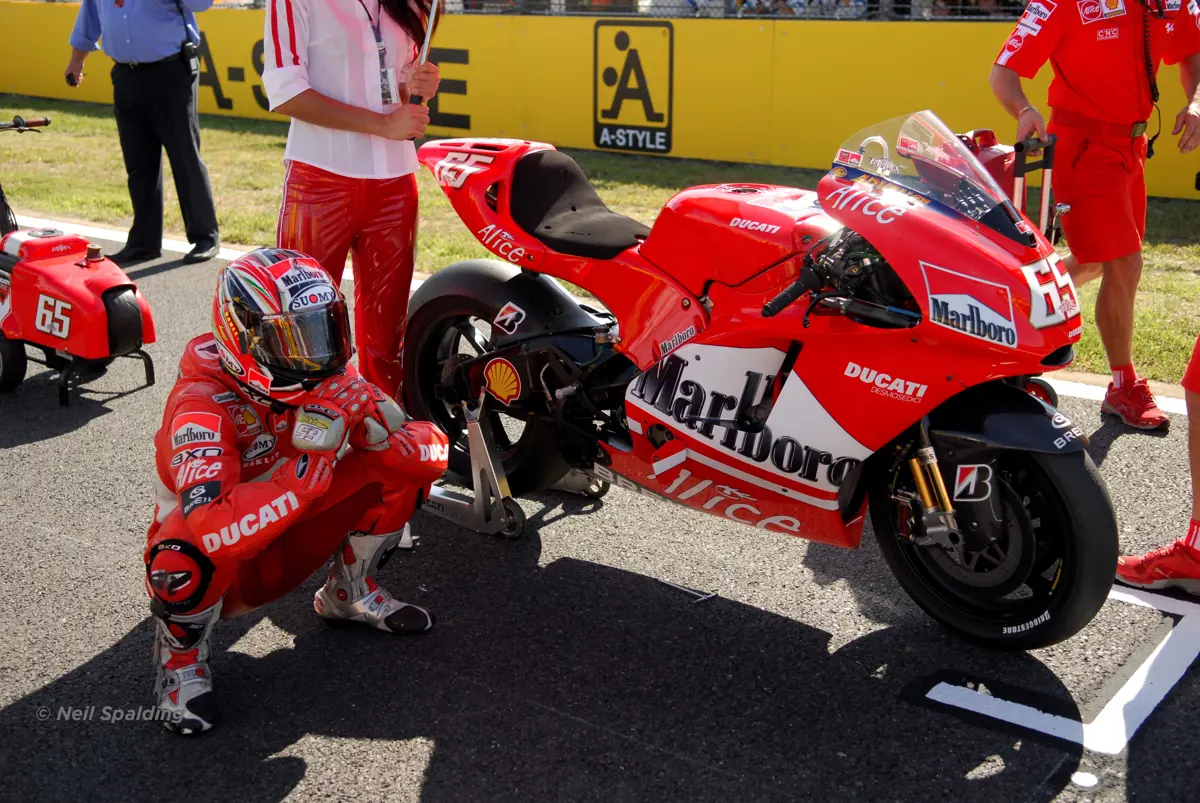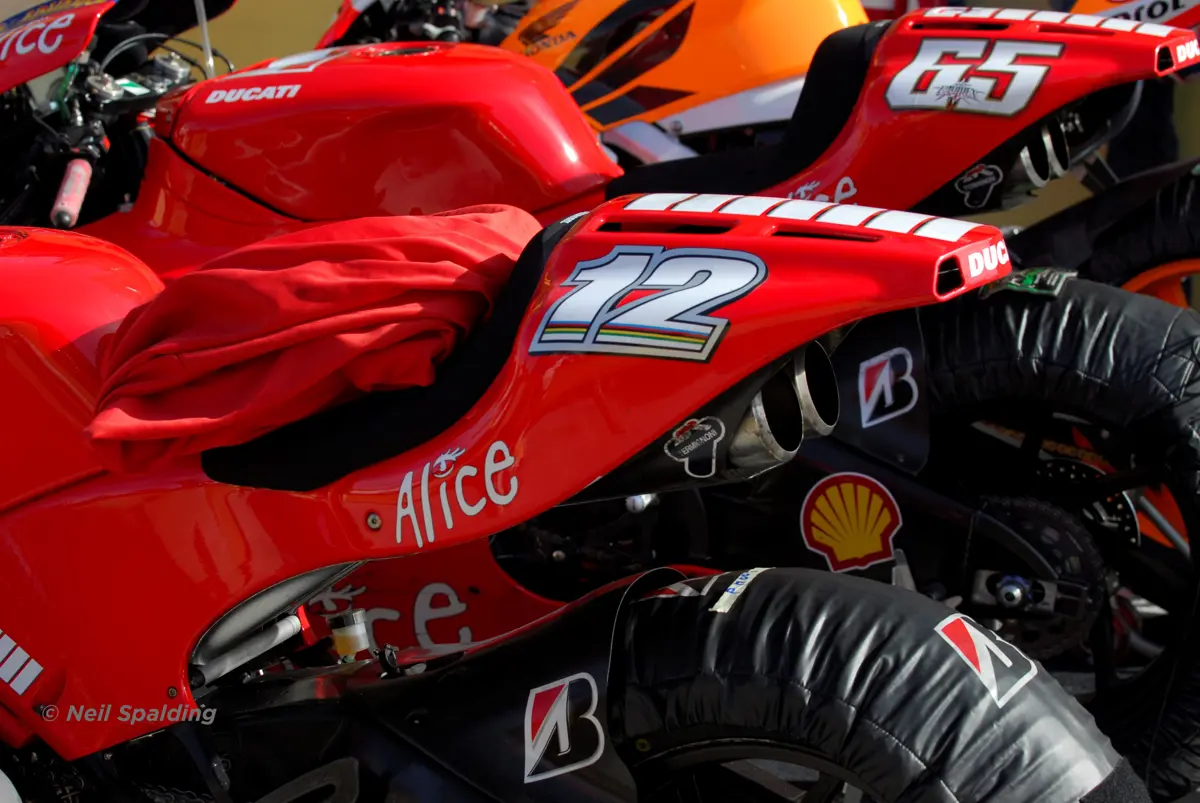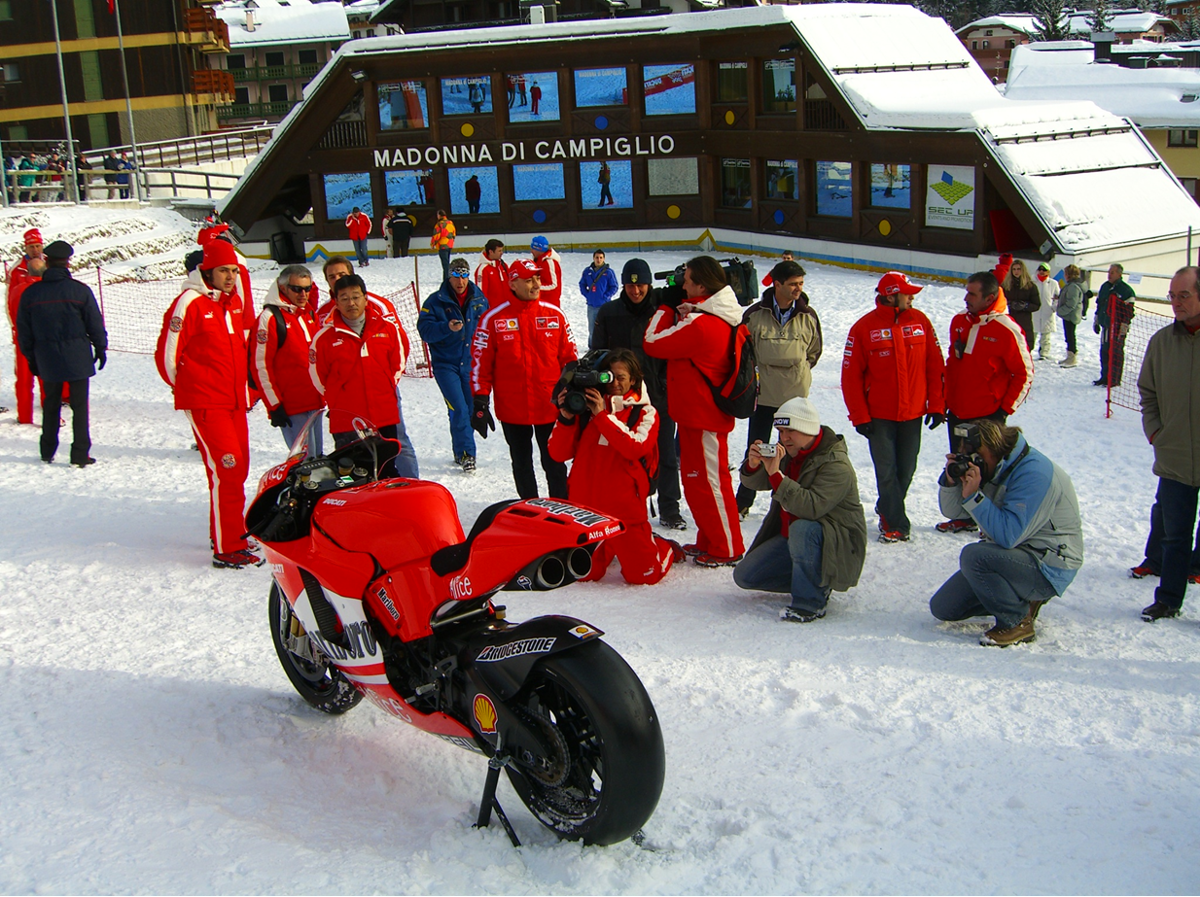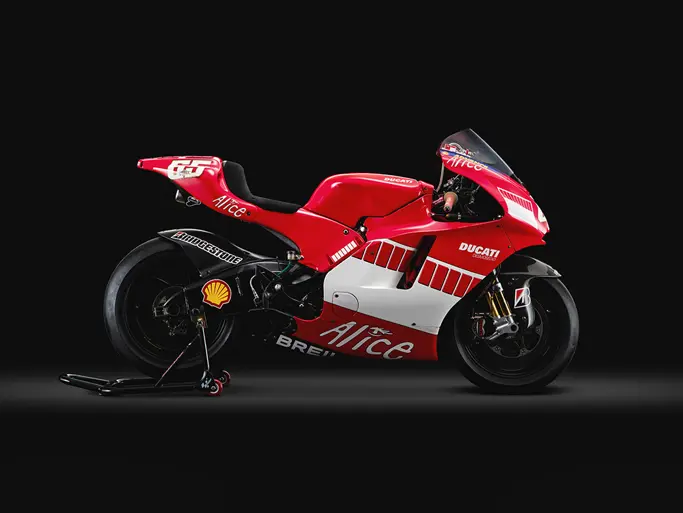As Jorge Martin screamed over the line at the 2024 Valencia Community Motorcycle Grand Prix in Catalunya just a few short weeks ago, his World Championship victory for Ducati marked the end of a historic season in which the Italian giant secured its sixth MotoGP Constructors’ World Championship and its fifth consecutive title since 2020. Tightening its grip on a sport that has been within its thrall since 2020, Ducati has totally dominated, edging ever closer to the spectacular run of six consecutive championships scored by compatriots Ferrari and the genius of Michael Schumacher. But the Italian outfit didn’t always have it so easy.
Ducati was a household name thanks to the Superbike World Championship, having earned its stripes during the 1990s. From 1993 to 1999 star rider, Carl Fogarty, swept aside all comers, winning the title a record four times and coming second on two occasions, while teammate Troy Corser took the title in 1996, as did Factory rider Troy Bayliss in 2001, all on Ducati’s blood-red machines. Grand Prix racing, however, was a different animal, and when Ducati Corse announced its return to the top-flight for the 2002 season, the Italians hadn’t contested a Grand Prix in over 30 years.
Ducati’s return coincided with a change in regulations that saw the newly minted MotoGP open its doors to four-stroke machines, with an accompanying maximum capacity not of 500 but 990 cc. But rather than opt for a variant of its highly successful twin-cylinder Superbike, the Ducati team was little doubt helped by being steered towards an all-new four-cylinder powerplant by none other than Piero Ferrari, a Ducati board member and with ties to an engineering consultancy in Modena called High Performance Engineering. It was fitting, and no surprise, that the 989-cc L4 engine developed by engineers had close links with Ferrari’s final and one-year-only, 3-litre Formula 1 V-12 powerplant—the Tipo 044/1—sharing both its 86 millimetre bore and four-valves-per-cylinder arrangement.

Ducati’s contemporary “Testaretta” twin-cylinder heads also benefitted from Ferrari know-how. The original design necessitated placing both opening and closing rockers between valves, forcing engineers to use a wide 40-degree included angle that in turn gave a sub-optimal combustion chamber. Ferrari had already covered the same ground in the early 1990s, leading to the development of an experimental five-valve Desmodromic cylinder head for its V12 Formula 1 engines. When retiring Ferrari engineer, Angelino Marchetti, was brought aboard to design a new cylinder head for the Ducati two-cylinder, his designs bore an uncanny resemblance to the earlier Ferrari head with revised rocker positions and a far more efficient 25-degree angle. Thanks to a power increase of at least 10%, the same design was used when it came time to create the Desmosedici Grand Prix engine.

Ducati spent 2001 and much of 2002 developing its new four-cylinder engine, and by pre-season testing for the 2003 MotoGP Championship, it was clear that the Italians were winning the arms race. The machine was a monster, blowing away the competition with its straight-line speed to the extent that its riders didn’t even need to slipstream—they simply pinned the throttle and rode past the opposition. Proof of their power advantage came in the opening round of the season at Suzuka, when Loris Capirossi powered from 15th place to second on the road by the first turn, leading the race on the first lap and going on to finish third overall. After a spectacular debut the new Ducati continued to impress, with a brilliant win at Catalunya after just six Grands Prix and then a stunning runner-up in the Constructors’ Championship by the season’s close, only beaten by Honda and Valentino Rossi.
Ducati built on its success for the 2004 season with a new bike. Though initially still fitted with the previous season’s “screamer” engine, the arrival of Yamaha’s strange sounding cross-plane crankshaft Grand Prix bikes ushered in new ideas on power delivery and grip. Ducati’s response was the thunderous “Twin Pulse” crankshaft that mimicked the power delivery of the firm’s big twin Superbikes, making their Grand Prix machines significantly more user-friendly. Progress had also finally been made on developing a workable traction control system, though the season was dominated by the generational talent of Valentino Rossi aboard the new Yamaha.
In 2005, Yamaha and Valentino Rossi’s dominance was almost absolute, the Italian scoring 11 wins and 16 podiums from 17 races—but there was hope for Ducati. The team had recently changed to Bridgestone tyres on tactical grounds, figuring that if Michelin and Dunlop had a bad weekend, anyone using Bridgestones would stand a better chance. While the first half of the championship was lost to tyre development, the partnership came good in the back half of the season when the circus rolled into the Far East. Because tyre manufacturers made tyres before the race, based on rider feedback and accurate weather forecasts, Michelin often had the advantage in Europe—but in Japan and Malaysia, it was the Japanese firm Bridgestone that had the upper hand. Ducati capitalised, with Capirossi scoring back-to-back wins at Motegi and Sepang—the first MotoGP victories for the Ducati team since Capirossi’s win in 2003.
The 2006 MotoGP season marked the end of an era for the formula, with maximum engine capacity being slashed to 800 cc for the 2007 championship. Ducati wanted to make the final 990 cc season count and came out swinging, unveiling its new GP6 Grand Prix bike alongside a revised rider lineup of Capirossi and Sete Gibernau at the foot of the 3 Tre ski course in Madonna di Campiglio, Italy.
"The Desmosedici GP6 represents an evolution of the GP5,” explained Ducati Corse MD Claudio Domenicali in 2006. “From the outside, it doesn't appear to present any marked differences from its predecessor, but it is, in fact, an important step forward. The bike is lighter, but we have also done a lot of work on its stiffness—with the frame, rims, and front forks—and, especially, at the rear of the bike. The composite structure that we call the seat support has been totally redesigned and stiffness has been increased by more than 80 per cent.”
Where the GP5’s front wheel had been known to move backwards under heavy braking—sometimes going as far as to rub the cylinder head’s carbon cover—the GP6 frame almost completely cured the problem. Its engine had also been reworked, with engineers dedicating hundreds of hours to reducing internal friction in an effort to boost power and reduce fuel consumption, which was always an issue for one of the highest-revving bikes on the grid. Ducati had finally got themselves into a position where the bike was capable of winning and all it needed was for Bridgestone to get the tyres right.

The opening round of the season confirmed that the recipe was finally right, as Loris Capirossi took pole position, a dominant victory, and fastest lap at Jerez on the Desmosedici GP6’s competitive debut, sending the Ducati faithful into raptures. A further three podium finishes in the first six Grands Prix saw Capirossi leave Mugello leading the Championship—vindication of the years of gradual improvement made by Ducati since 2003. The Italian team finally seemed on course to end the hegemony of Valentino Rossi, but fate had other ideas. At the next round in Catalunya a dramatic crash at the first corner collected both Capirossi and teammate Gibernau, and it was several rounds before both were fully fit again.
Once healthy, Capirossi quickly regained his pre-crash form with a win at Brno on 20 August, and at the start of September he headed to the three ‘flyway’ races in Malaysia, Australia, and Japan and competed with the spectacular GP6 currently offered via Sealed: frame chassis D16GP6LC2. The battles fought on this bike live long in the memory of MotoGP fans, with a titanic struggle between Rossi and Capirossi in Malaysia underlining both the potential of the Ducati and the determination of the team. Rain put paid to the Italian’s chances in Australia, where he finished seventh, before a truly spectacular display at Japan’s Twin Ring Motegi Circuit. Having taken pole position by more than a quarter of a second, Capirossi put on a masterclass in motorcycle racing, leading from the moment the lights went out until the chequered flag was waved 24 laps later, also setting a new lap record. It was a seismic win not only for Ducati, but for tyre partner Bridgestone. The GP6 didn’t just beat its Japanese rivals Yamaha and Honda, but did so in their own backyard.

Just over a month later MotoGP arrived in Valencia for the final round of the championship, which at that point had slipped from Ducati’s grasp but had yet to be decided overall. Ultimately, popular American rider Nicky Hayden would take the MotoGP title in a narrow victory over ‘The Doctor’ Valentino Rossi, winning his first and only World Championship title. The race, however, belonged to Ducati, with Capirossi coming home a close second and setting another new lap record behind a resurgent Troy Bayliss, who qualified second in his one-off recall to the Italian team before leading the entire race. He became the first man to win both a Superbike and MotoGP race in the same season, in the process underlining the immense promise of the Desmosedici GP6.

With that, one of the most exciting periods of MotoGP drew to a close.
The machines that heralded the start of this golden era in 2002 were nothing short of animals that could wheelie in any gear, and the riders who tried to tame them—often battling burns by the end of races—were true gladiators of the sport. The Desmosedici GP6 was the final and most developed variant of these immensely powerful 990 cc Grand Prix bikes and is representative of a period of racing that will never be repeated. Of that incredible cohort of racers, chassis LC2 is a fascinating survivor and a true time capsule. Totally unchanged from its final podium finish in 2006 and still bearing the scrutineering sticker from that very race in Valencia, even its handlebar grips—worn from the sheer effort of hauling the machine around corners—are as they were when it took its final chequered flag.

The Desmosedici GP6 was a truly remarkable machine that laid the foundation for the success that would follow. And while it may have been smaller and less powerful, the 800cc Ducati GP7 that followed in 2007 truly stood on the shoulders of giants. With the new model and young rider Casey Stoner, Ducati scored a historic double, winning both the MotoGP Riders’ and Constructors’ titles—firsts for any European team in MotoGP.

Had it not been for Loris Capirossi fatefully catching the brake lever of teammate Gibernau’s motorcycle during the seventh race of the 2006 season, it’s entirely possible that the champagne could have popped in Borgo Panigale a year earlier. For further details, click here.




